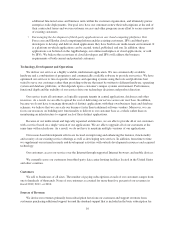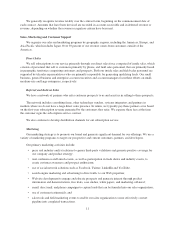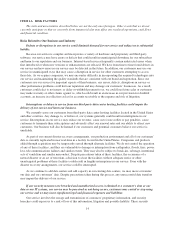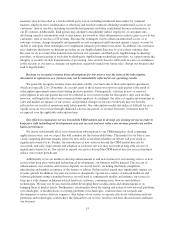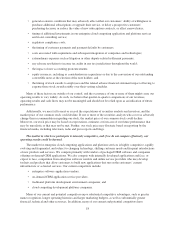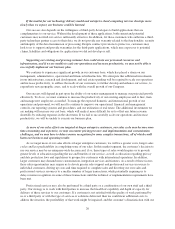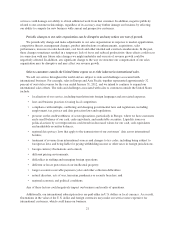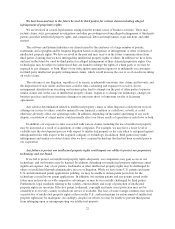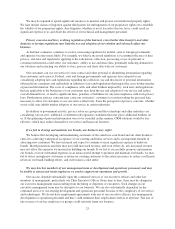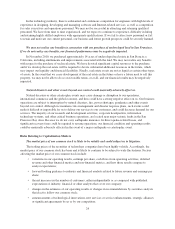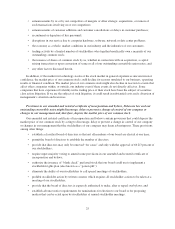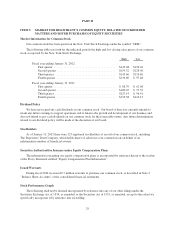Salesforce.com 2012 Annual Report Download - page 24
Download and view the complete annual report
Please find page 24 of the 2012 Salesforce.com annual report below. You can navigate through the pages in the report by either clicking on the pages listed below, or by using the keyword search tool below to find specific information within the annual report.If the market for our technology delivery model and enterprise cloud computing services develops more
slowly than we expect, our business could be harmed.
Our success also depends on the willingness of third-party developers to build applications that are
complementary to our service. Without the development of these applications, both current and potential
customers may not find our service sufficiently attractive. In addition, for those customers who authorize a third-
party technology partner access to their data, we do not provide any warranty related to the functionality, security
and integrity of the data transmission or processing. Despite contract provisions to protect us, customers may
look to us to support and provide warranties for the third-party applications, which may expose us to potential
claims, liabilities and obligations for applications we did not develop or sell.
Supporting our existing and growing customer base could strain our personnel resources and
infrastructure, and if we are unable to scale our operations and increase productivity, we may not be able to
successfully implement our business plan.
We continue to experience significant growth in our customer base, which has placed a strain on our
management, administrative, operational and financial infrastructure. We anticipate that additional investments
in our infrastructure, research and development, and real estate spending will be required to scale our operations
and increase productivity, to address the needs of our customers, to further develop and enhance our service, to
expand into new geographic areas, and to scale with the overall growth of our Company.
Our success will depend in part upon the ability of our senior management to manage our projected growth
effectively. To do so, we must continue to increase the productivity of our existing employees and to hire, train
and manage new employees as needed. To manage the expected domestic and international growth of our
operations and personnel, we will need to continue to improve our operational, financial and management
controls, our reporting systems and procedures, and our utilization of real estate. The additional investments we
are making will increase our cost base, which will make it more difficult for us to offset any future revenue
shortfalls by reducing expenses in the short term. If we fail to successfully scale our operations and increase
productivity, we will be unable to execute our business plan.
As more of our sales efforts are targeted at larger enterprise customers, our sales cycle may become more
time-consuming and expensive, we may encounter pricing pressure and implementation and customization
challenges, and we may have to delay revenue recognition for some complex transactions, all of which could
harm our business and operating results.
As we target more of our sales efforts at larger enterprise customers, we will face greater costs, longer sales
cycles and less predictability in completing some of our sales. In this market segment, the customer’s decision to
use our service may be an enterprise-wide decision and, if so, these types of sales would require us to provide
greater levels of education regarding the use and benefits of our service, as well as education regarding privacy
and data protection laws and regulations to prospective customers with international operations. In addition,
larger customers may demand more customization, integration services and features. As a result of these factors,
these sales opportunities may require us to devote greater sales support and professional services resources to
individual customers, driving up costs and time required to complete sales and diverting our own sales and
professional services resources to a smaller number of larger transactions, while potentially requiring us to
delay revenue recognition on some of these transactions until the technical or implementation requirements have
been met.
Professional services may also be performed by a third party or a combination of our own staff and a third
party. Our strategy is to work with third parties to increase the breadth of capability and depth of capacity for
delivery of these services to our customers. If a customer is not satisfied with the quality of work performed by
us or a third party or with the type of services or solutions delivered, then we could incur additional costs to
address the situation, the profitability of that work might be impaired, and the customer’s dissatisfaction with our
20


